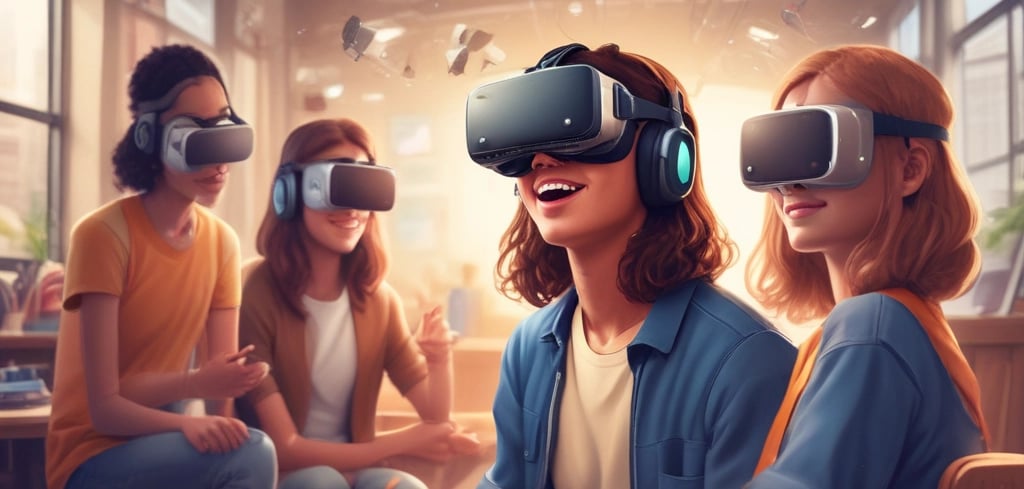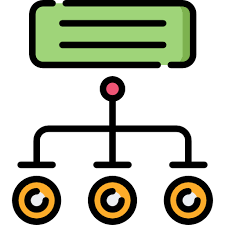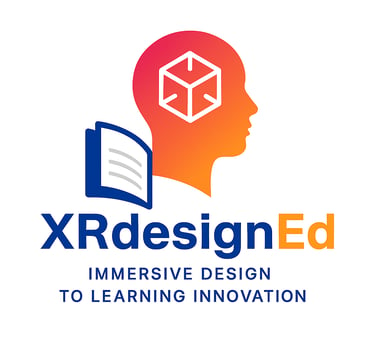Innovative Projects
Showcasing immersive VR environments for education.


VR Microlearning
Project 1 :
Exploring Human Body Systems in Academic English
(C1–C2)
Immersive Microlearning Experience on the Edstutia Platform
This VR microlearning project was designed for secondary education students who are non-native English speakers. The primary goal was to strengthen academic English proficiency at the C1–C2 level while deepening understanding of the human body systems through an engaging, immersive, and interactive VR environment.
🧪 Preparation & Instructional Design
The project development included two layers of preparation:
Teacher-Developer Preparation
Defining learning objectives that balance biology content with academic language outcomes.
Designing four distinct VR stations, each aligned with a specific body system and interactive task.
Creating supporting materials, such as vocabulary banks, question cards, matching exercises, and prompts for drawing or role-play.
Testing VR mechanics (spawning objects, chat features, 3D drawing tools, quiz boards) to ensure smooth learner experience.
Building scaffolding into the activities so students gradually move from recognition (multiple choice) to production (drawing, describing, role-play).
Student Prework
Before entering the VR space, students completed a preparatory 360° video activity from National Geographic introducing the 10 major human body systems. This gave them exposure to academic English terminology and basic system functions, reducing cognitive load during the immersive session. Students were also provided with a pre-reading vocabulary list and guiding questions to prime them for interactive use of terminology.
📌 Learning Objectives
By the end of the project, students were expected to:
Identify, describe, and locate major organs of selected human body systems in English.
Use advanced academic vocabulary related to anatomy in both spoken and written forms.
Collaborate effectively in English to solve problems, complete tasks, and describe processes.
Apply experiential learning by engaging with 3D objects, tools, and interactive VR stations.
Reflect on content and language learning, recognizing connections between subject knowledge and language acquisition.
Structure of the VR Experience
The immersive environment was structured around four interactive stations, each focusing on one system, and combining language tasks with scientific knowledge:
Cardiovascular System – Students answered multiple-choice questions about the heart, blood vessels, and blood flow. Each correct response triggered success sounds and clapping effects, reinforcing motivation.
Skeletal System – Students spawned 3D bone models and placed them in the correct locations on a skeleton structure. The activity required naming bones and using precise anatomical vocabulary.
Digestive System – Using a 3D drawing tool, students marked where organs such as the stomach, intestines, and liver are located. To support accuracy, cards with multiple-choice questions guided their decisions.
Endocrine System – Students engaged in a secret chat card game. Two teams took turns describing specific glands (e.g., pituitary, thyroid, adrenal) while the other team guessed. This simulated the hidden but vital communication functions of the endocrine system.
Each station was designed to last 5–7 minutes, keeping the pace lively while encouraging focused engagement.
🧠Pedagogical Principles
The project was grounded in established instructional design and language learning principles:
CLIL (Content and Language Integrated Learning): Learners acquired scientific content (body systems) while simultaneously strengthening English proficiency.
Experiential Learning (Kolb): Students learned through direct interaction, reflection, and application, turning abstract concepts into tangible experiences.
Collaborative Learning: Group-based challenges promoted peer learning, negotiation of meaning, and authentic use of English in problem-solving.
Gamification: The use of challenges, instant feedback (clapping and success sounds), and competitive team play increased motivation and engagement.
Scaffolding: Activities were sequenced from receptive tasks (MCQs) to more productive ones (drawing, describing, role-play), ensuring learners were supported at every step.
Microlearning: Short, focused activities reduced cognitive overload, enabling sustained attention and better knowledge retention.
🛠 Tools and Features Used
The project leveraged the Edstutia platform’s immersive features, including:
Virtual whiteboards for drawing and brainstorming.
3D spawning tools to create and manipulate bones or organs.
Multiple-choice quiz panels to check comprehension.
Chat and card systems for secret chat role-play and vocabulary prompts.
Sound feedback (clapping, success tones) to reinforce achievement.
These tools supported both content mastery and language practice, ensuring that learning objectives in both domains were met.
🧾 Assessment & Feedback
Formative Assessment: Learners received real-time feedback at each station (clapping sounds, peer discussion, teacher observation).
Summative Assessment: A short post-VR quiz tested vocabulary recall and system knowledge.
Experiential Assessment: Success was measured by how effectively students collaborated, communicated, and applied vocabulary in context.
🚀 Impact and Reflection
By combining biology content, English language practice, and immersive technology, this VR microlearning project created a memorable, high-engagement learning experience. Students not only practiced academic English at an advanced level but also built a deeper understanding of how human body systems function.
The project highlights the potential of VR to bridge subject learning and language learning, showing how immersive tools can transform traditional lessons into interactive, collaborative, and effective educational experiences.






